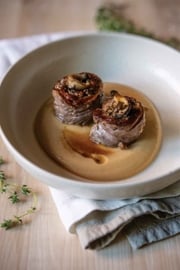Baked Coconut Shrimp with Apricot Dipping Sauce

This classic steakhouse appetizer has been given a healthy makeover by baking instead of deep frying.
3/4 cup (180 mL) shredded, unsweetened coconut
1/2 cup (125 mL) panko bread crumbs
2 Tbsp (30 mL) curry powder
1 tsp (5 mL) coarse sea or kosher salt
2 egg whites
1 pound (450 g) shrimp, peeled and deveined
1 cup (250 mL) apricot jam
2 Tbsp (30 mL) low-sodium soy sauce
3 Tbsp (45 mL) scallions, finely chopped
1 Tbsp (15 mL) fresh lime juice
1/2 tsp (2 mL) fresh black pepper
Dash of hot sauce (optional)
Preheat oven to 375 F (190 C). Mix coconut with bread crumbs, curry powder, and salt; set aside. Beat egg whites in medium bowl until slightly foamy. Dip shrimp in egg whites and coat with coconut mixture. Repeat to form a double coating.
Place shrimp on baking sheet lined with aluminum foil or parchment paper; bake for 10 minutes.
Meanwhile heat apricot jam in small saucepan over medium heat. Stir in soy sauce, scallions, lime juice, black pepper, and hot sauce; heat for a few minutes. Serve coconut shrimp with jam sauce. Makes 6 servings.
Each serving contains: 290 calories; 19 g protein; 5 g total fat (3 g sat. fat, 0 g trans fat); 44 g carbohydrates; 2 g fibre; 397 mg sodium
source: "Organic Steak Night In", alive #322, August 2009





